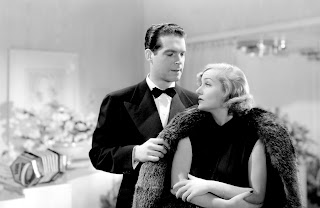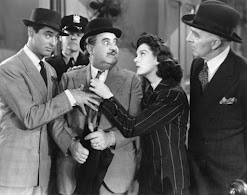 Watchingwell
Watchingwell
Curated classic films
More on Sacrifice
Looking back, I see that I thought that last December was the
right time it to talk about sacrifice – because we were all in
that place where we had to forego many parts of a normal life for the common
good – the health of the community.
This year I was thinking about sacrifice in a different
light, having heard a lot of whining from the folks who are tired of foregoing normal
life. In fact, some have declared that
they are done with the whole health-of-the-community thing – and they are
declaring it in very unfortunate ways.
This made me think of my parents’ generation and how I was so glad that
they fought Nazi Germany and Imperial Japan and we don't have to. I don’t know – maybe, people today would come through if push came to shove, but let’s remind ourselves of what another
generation had to forego and was willing to do for the common good.
Some people, in Europe and Asia, were meeting life-and-death
decisions daily and demonstrating how ordinary people act in extraordinary
circumstances. American audiences were fed inspiring tales of their suffering
and sacrifice to boost public support of the war effort.
A village in an unnamed country, which seems a lot like occupied
France, is the setting for a fine drama from 1943 directed by Jean Renoir. In This Land is Mine, Charles
Laughton plays a timid schoolteacher, babied by his mother, played by Una O’Connor,
who secretly loves Maureen O’Hara, and endures fear and scorn under the German
occupation of his village until he finds courage at the very end. It is the tale of a quite ordinary man who
undergoes a transformation when the situation requires. Good supporting performances from George
Sanders and Kent Smith.
Norway is the setting for two films of resistance to Nazi occupiers,
both from 1943. The first, Edge of Darkness, is one of Errol
Flynn’s best roles as a fisherman who leads his village in action against the
invaders. Directed by Lewis Milestone,
and also starring Ann Sheridan as Flynn’s fiancée, with Walter Huston and Ruth Gordon.
The other film deals with resistance in a less violent, but possibly more dangerous form. Merle Oberon stars as a woman who is hated as a collaborator, but in reality, is getting information from the Germans that she passes on to the Norwegian underground. The film, First Comes Courage is notable also because it is directed by Dorothy Arzner, the only female director of her time in Hollywood.
Perhaps the best-known film of ordinary people doing the extraordinary
in times of war, Mrs. Miniver, from 1942, swept the Academy Awards
for Best Picture, Best Actress (Greer Garson), Best Actress in a supporting
role (Teresa Wright), and best director (William Wyler), as well as Best Cinematography,
Black and White, and Best Writing, Screenplay.
It has been said that it is pure propaganda (and Winston Churchill was
supposedly in agreement) – one perfect, plucky English family being bombed,
participating in the Dunkirk evacuation, capturing a downed German pilot, and
losing a family member, and still winning a prize at the garden show – all designed
to win support for U.S. aid to Britain, holding out against Germany. Nevertheless, one can’t help getting caught
up – Greer Garson is so convincing – in this family’s story.
Before we leave the subject of Europeans responding to extraordinary times, I would draw your attention to a little film that I saw in the sixties, while not from the Golden Era, is pretty old and I thought it quite inspiring when I saw it. The film, Conspiracy of Hearts from 1960 is the story of a group of nuns in Italy, led by Lili Palmer, and featuring a fine cast, who hide of group of Jewish children from deportation. It is actually very exciting, directed by Ralph Thomas.
Sometimes, it was necessary to put Americans in Europe to illustrate the dangers of Nazi occupation.
Cary Grant is a reporter in Once Upon a Honeymoon (1942) who tracks down Ginger Rogers, a Burlesque star, who has just married a German ambassador played by Walter Slezak. It seems that bad things happen wherever Slezak goes and Cary wants an interview to find out his Nazi connections. Directed by Leo McCarey, who can’t resist a few touches of comedy inserted into the dire situation. But even so, when is Cary Grant not worth watching?
A professor and his new wife are recruited to contact a colleague
in Germany while on their honeymoon, a man who has vital information about a German
secret weapon. Above Suspicion (1943), adapted from the novel by
Helen MacInnes, stars Joan Crawford and Fred MacMurray, with Basil Rathbone and
Conrad Veidt playing his usual villain role. Directed by Richard Thorpe.
Note: Conrad Veidt, pictured above, in between MacMurray and Crawford, recognizable to those familiar with films from the World War II era as the actor most often cast as the Nazi commandant. His claim to fame before this was starring in the 1920 silent classic, The Cabinet of Dr. Caligari. But when the Nazis came to power in Germany, he chose to leave and relocate to England with his wife, and eventually became a British subject. He was actively anti-Nazi, donating the major portion of his personal fortune to the British government for the war effort, and had it in his contract that he only play Nazis as villains.
Back on the home front, Americans were adapting to shortages of
goods and men diverted to the war effort. Women went out to work in factories
and tried to manage alone. In Tender Comrades (1942), several
women doing war work decide to pool their resources and share a house and
housekeeper. Although the major part of
the story is about Ginger Rogers and her romance with new husband, Robert Ryan,
who is now fighting overseas, Kim Hunter and Ruth Hussey add different
experiences to their little community. Although we can laugh about it now, at
the time, it was examined by the thought police of the House Un-American Activities
Committee, as a possible endorsement of communism (‘Comrades’ right in the
title!) because of the concept of sharing resources and contributing what one
is able being so un-American. After
hearing this, Ginger Rogers made statements criticizing the picture, even though she
turned in a rather good performance. Directed by the very suspect director,
Edward Dmytryk.
Housing shortages were most acute in Washington D.C. where the population swelled, directing the war effort. Jean Arthur
thought it was her patriotic duty to sublet a room in her apartment, but hadn’t
planned on it being Charles Coburn, or that he would sublet part of his room to
Joel McCrea. So begins the hilarious problems
for Jean in The More the Merrier, directed by George Stevens in
1943. Charles Coburn won an Oscar for actor
in a supporting role. One of the great screwball comedies.
Robert Cummings was working in a west coast arms factory in Saboteur,
the 1943 Alfred Hitchcock film, when circumstances force him to flee
cross-country from a charge of murder. Along the way, he encounters Priscilla Lane, a network of spies, and a plan to do damage to a naval launch, which he decides to foil. Pretty exciting all the way, especially the ending at the Statue of Liberty.
Also from 1942, Alan Ladd plays a gangster who is drafted and does
all he can to get out of it, to no avail, in Lucky Jordan,
directed by Frank Tuttle. Also starring Helen Walker and Sheldon Leonard, Ladd’s
character goes AWOL and gets involved with marketing some secret plans to
foreign agents. But along the way, he comes to realize that he really doesn’t
like the guys on the other side and starts to think it’s worth fighting for
something besides himself.
While the war was being fought, there were many fine films that paid tribute to the fighting men who had volunteered or been drafted to serve. This certainly was a war of ordinary men being called upon to do extraordinary things. But there were ordinary women who did extraordinary things at the battlefront. Two films from 1943 that I have mentioned in previous posts are an illustration of this. Cry Havoc starring Margaret Sullavan, Joan Blondell, Ann Southern, Fay Bainter, as nurses on Bataan in the days before the surrender. Directed by Richard Thorpe, its gritty depiction of the conditions under which they worked really affected me as a child when I saw it on TV. Until then, women war heroes were few: Clara Barton and Florence Nightingale.
I didn’t see the other film on the subject, So Proudly We Hail until much later, and it has a slightly better reputation because of the production values and the star power of Claudette Colbert, Paulette Goddard, and Veronica Lake. Directed by Mark Sandrich.
*Recently, I found this fascinating 27-minute film about the
nurses. Check it out to get the real story. https://archive.org/details/WeAllCameHome
Speaking of Claudette Colbert, I will finish with one my favorite holiday films that also could be called the American equivalent to Mrs. Miniver. Sure, the family in Since You Went Away, is too perfect, too upper-middle class to have to take in a lodger, with the perfect, devoted maid (Hattie McDaniel) who works for no pay, but with the polish of these actors and filmmakers -- director, John Cromwell, music by Max Steiner, cinematography by Stanley Cortez and Lee Garmes, one is drawn into their story. Colbert's husband is serving overseas, Jennifer Jones and Shirley Temple are her daughters. Joseph Cotten is a friend of the family who visits while on leave and Monty Woolley is the disgruntled lodger whose grandson, Robert Walker, is a great disappointment to him, and who nevertheless becomes romantically involved with Jennifer Jones (At the time, his real-life wife and shortly to separate, but convincing as a couple here.) Agnes Moorehead is the voice of the not-so-patriotic home front, presented as a contrast to Colbert and her girls, who are happy to be doing their part. For all the contrivances to win our sympathy, I defy anyone to watch this completely dry-eyed, especially, the train station farewell.
Happy Holidays!



































































